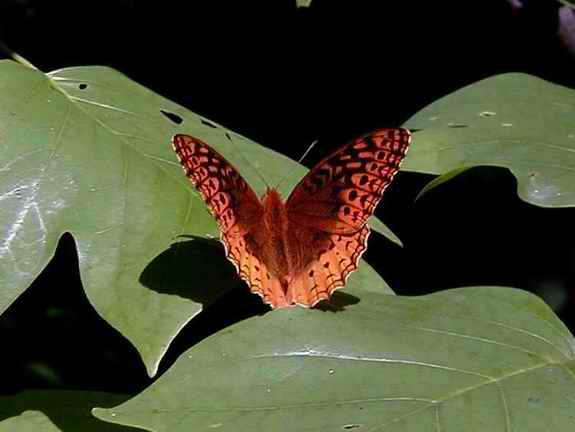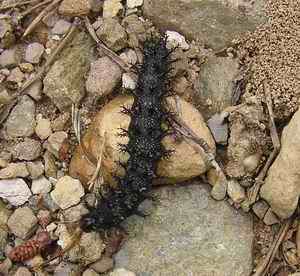|
Return to Hiker's Notebook Home Page
Common Name: Great Spangled Fritillary, Silverspot - The Latin word for dice-box is fritillus; the common name refers to the similarities in the appearance of the spots on the dorsal (top) wing surface of the butterfly to the numerical dot marks on a die. Silverspot refers to silver dots on the ventral (underside) wing surface. The adjectives Great and Spangled are applied to this species as one of the larger and more colorful of the fritillaries.
Scientific Name: Speyeria cybele - The genus is named for A. Speyer, a 19th Century German botanist; the species is named for Cybele, the Greek goddess of caverns, who personified the earth in a primitive and savage state. The cult of Cybele was celebrated by a group of priests called the Galli, who led convulsive dances with drums and flutes, the flight of the fritillary butterfly perhaps suggestive of their movements. Cybele was the mother of Midas who was given the golden touch by Dionysus and who later killed himself by drinking the blood of a bull because Apollo gave him the ears of an ass.
The Great Spangled Fritillary is a member of the family Nymphalidae (from nymphs, who were minor deities of nature in Greek and Roman mythology, often depicted as maidens living in the mountains and meadows). The family is commonly known as the "brush-footed butterflies" to account for an anatomical anomaly; their two front legs are stunted and covered with short hairs that resemble brushes; they have only four functional legs. Included in the family are a wide variety of butterflies, ranging from those with distinctly different coloration, like the Mourning Cloak (Nymphalis antiope), to those with similar coloration, like the American Painted Lady (Cynthia virginiensis), the Red Admiral (Vanessa atalanta), and the Comma (Polygonia comma).
The larvae of brush-footed butterflies are distinctive, featuring six rows of branching spines that extend down the length of the back. These spines are defensive, warding off predators that consist primarily of birds, spiders and other insects. The caterpillar stage is very important to the life cycle of the fritillary. Adult fritillaries lay their eggs on the dead leaves of violets in the fall, the caterpillars hatching shortly thereafter. Overwintering in the larval stage, the fritillary survives under the leaf litter until the violets which constitute their primary food emerge in the springtime. The caterpillars feed primarily at night as an added precautionary defense against predators. Because of their almost exclusive dependence on violets, fritillary populations are subject to fluctuations that mirror environmental conditions; during droughts violet growth is sparse and larvae survival is accordingly diminished. Following the pupa stage, they emerge as adults in midsummer, feeding solely on the nectar of flowers, laying their eggs to compete the complex metamorphic life cycle.
The complex colorful pattern on the wings of the fritillary (from which it draws the "dice-box" analogy to its nomenclature) is due to wing scales that characterize all members of the order Lepidoptera (which is from the Greek lipis which means scale and ptera which means winged). Scales are formed from a single cell and are held at an angle of about 45 degrees to the wing membrane. Each scale is a single color, the overall image of the butterfly wing being the result of the merging of colors, much like the pointillist paintings of the French impressionists. According to research in the filed of evolutionary developmental biology (known as Evo Devo), scales are based on the same genes that flies use to make sensory bristles, evolving to become flat, wide and insensate. Butterflies and moths emerged with scales probably as a means of defense, the easily detached and slippery scales affording a means of escape from spider webs and clumsy predators.
The colors of the wing scales and the geometric patterns that they form are another matter however. An overall plan to the organization of butterfly wings began to emerge in the early 20th century as comparative biologists observed that each butterfly wing had a set of characteristic patterns at its base that served as the template from which divergence occurred. This pattern, as may be noted in the fritillary, is repeated to some extent in each region bounded by the veins. The key to understanding the speciation of butterflies is that each spot has the ability to evolve its size and shape independently. According to Sean Carroll in "Endless Forms Most Beautiful," spots are formed at a specific place on the wing at a specific time by the same gene that controls the location and formation of all insect appendages, the distal-less gene (so-named because when mutated, the outer, or distal side of fruit fly limbs was absent). Random variations in the markings of the individual butterfly wings that were more survivable were more successful; those we now observe are a validation of Darwin's theory. |

